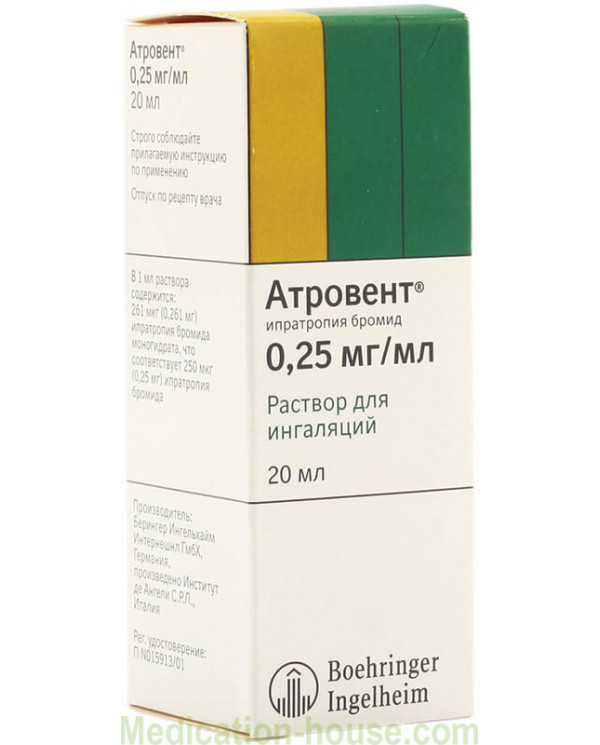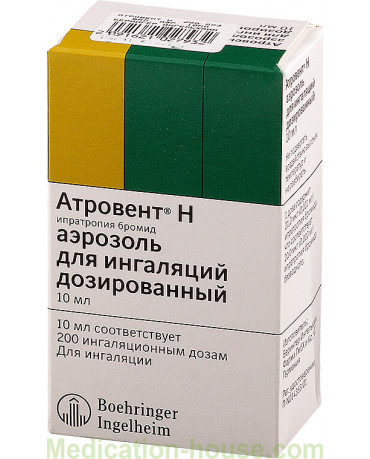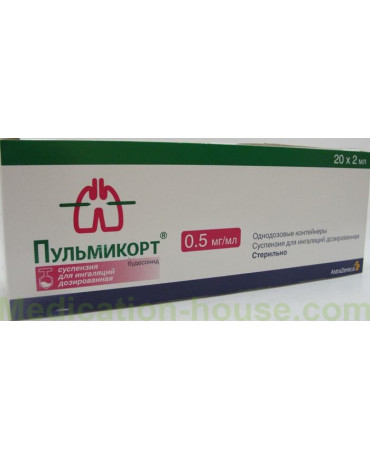Atrovent instruction
You can buy Atrovent solution here
Composition
Atrovent Inhalation Solution contains ipratropium bromide (250 mcg) as an active ingredient (INN), and it also contains additional ingredients: EDTA, benzalkonium chloride, sodium chloride, hydrochloric acid, water.
Atrovent N, an aerosol for inhalation, contains ipratropium bromide (21 mcg in a single dose, form of monohydrate), as well as additional ingredients: citric acid, ethanol, prepared water. Propellant: tetrafluoroethane.
Release form
The drug is available in the form of a metered aerosol for inhalation, solution. Aerosol is a colorless transparent liquid in which there are no visible particles. Available in bottles of 10 ml (contains 200 doses), as well as 15 ml (contains 300 doses). In one dose of the drug - 20 μg of active substance. The preparation is contained in steel cans equipped with a metering valve and a mouthpiece.
Atrovent Inhalation Solution is a colorless transparent liquid, in 1 dose of which 250 micrograms of active substance is contained. The solution is packaged in 20 ml dark glass bottles.
pharmachologic effect
The active substance of the drug is ipratropium bromide, an m-cholinergic receptor blocker. The molecule of this substance resembles acetylcholine. Once in the tracheobronchial tree, it binds to acetylcholine receptors.
Under the influence of solution Atrovent, acetylcholine receptors are blocked in the muscles of the bronchi. In this case, there is almost no undesirable anticholinergic effect on the smooth muscles of the urinary tract, digestive tract, etc.
As a result, a bronchodilating effect is noted, the level of secretion of the glands of the bronchial mucosa is reduced. When using the product, it is possible to prevent the reflex spasms of the bronchi that occur due to the influence of those factors that provoke the development of bronchospasm (cool air, cigarette smoke, etc.).
Atrovent solution also prevents the development of bronchospasm, which develops due to the pathological effects of the vagus nerve. In the treatment of these drugs in people suffering from bronchial asthma, external respiration is significantly improved. The manifestation of the effect of bronchodilation is observed approximately 10 minutes after inhalation and lasts for six hours.
Pharmacodynamics and pharmacokinetics
Atrovent solution provides a pronounced bronchodilator effect and does not allow the manifestation of bronchospasm. Under its influence, the secretion of the glands of the bronchial mucosa decreases.
If the drug is introduced into the body through inhalation, the absorption level is very low. The concentration level of the active substance in blood plasma is very low, so it can be determined only if large doses of ipratropium bromide are taken.
It is excreted mainly through the intestines, while 25% is released unchanged, the remains of the substance are excreted in the form of metabolites.
Indications for use
Solution Atrovent is prescribed for the following diseases and conditions of the body:
chronic obstructive pulmonary disease, accompanied by emphysema;
chronic obstructive pulmonary disease, without emphysema;
bronchial asthma (exception - a severe form of the disease);
bronchial asthma, in which concomitant diseases of the vessels, heart are noted;
bronchospasm provoked by colds and infectious diseases;
bronchospasm developing after surgery;
diagnosis of reversibility of bronchial obstruction;
preparation for the introduction of aerosol products.
Contraindications
You can not appoint solution Atrovent in the following cases:
a high level of sensitivity to ipratropium bromide, atropine, additional ingredients;
suspected pregnancy;
first trimester of pregnancy;
the presence of pathologies of the bronchopulmonary system in children who are not yet 6 years old (aerosol should not be used);
pathological manifestations in the bronchopulmonary system in children under five years of age (you can not use the solution).
With caution, Atrovent solution is prescribed to patients with angle-closure glaucoma, prostate hyperplasia, urinary disorders, cystic fibrosis, as well as women who are breastfeeding.
Side effects
When using Atrovent in the form of a solution and aerosol during the treatment process, a number of side effects can be noted:
dry mouth, nausea;
headache,
sputum thickening;
tachycardia, atrial fibrillation;
deterioration of the motor function of the digestive tract;
urinary retention, constipation;
swelling, paresis;
erythema multiforme;
laryngospasm, bronchospasm, cough;
glaucoma;
urticaria, irritation of the nasal mucosa.
Instructions for use Atrovent (method and dosage)
If the patient uses Atrovent solution, the instructions for use should be carefully studied and followed.
As a rule, the dosage of the drug is set individually. Instructions for use Atrovent solution for inhalation provides that the drug for adults and children who are already six years old, is prescribed two inhalations, 4 times a day.
For the treatment of children, the drug should be used exclusively under the supervision of a doctor and adhering to the dosage that he prescribed.
With the complex treatment of bronchial asthma, children under 12 years of age are prescribed 1-2 inhalations every six hours, if necessary.
For the treatment of COPD, Atrovent may be used as a solution for inhalation. 10-20 drops of the drug are filled into the inhaler, inhalations are carried out as necessary. In this case, adults should not receive more than 2 mg of the drug per day, children –1 mg of the drug.
The necessary dose of the drug, which was previously diluted by phys. solution. The result should be 4 ml of solution. The dose should be prepared every time before inhalation.
Overdose
There were no specific symptoms of an overdose. The intensity of side effects may increase when using too large a dose of the drug, in particular, the manifestation of tachycardia, dry mouth, paresis is possible. Symptomatic therapy should be given.
Interaction
If Atrovent solution is prescribed simultaneously with cromoglycic acid, a decrease in the effectiveness of both agents is possible. With simultaneous treatment with xanthine derivatives, β2-adrenergic agonists, a more pronounced bronchodilator effect is noted.
The anticholinergic effect of Atrovent is enhanced with simultaneous therapy with antiparkinsonian drugs, tricyclic antidepressants, quinidine.
Cisapride reduces the severity of Atrovent's influence. With the joint treatment of Atrovent solution and β2-adrenergic agonists, an exacerbation of the condition in patients with angle-closure glaucoma is possible.
Do not practice aerosol treatment in parallel with disodium cromoglycate, as two aerosols can interact physically.
Storage conditions
Atrovent solution should be stored at a temperature not exceeding 25 degrees Celsius in a dry place. Do not freeze the solution.
Shelf life - Atrovent can last 3 years.
special instructions
The solution for inhalation contains a preservative benzalkonium chloride and a stabilizer. Therefore, there is information that when using large doses of the drug, these substances can provoke the development of bronchospasm.
Do not take a dose that exceeds the allowable daily, both with short and long-term therapy.
Caution is used to treat people suffering from angle-closure glaucoma and urination disorders, manifested in connection with benign prostatic hyperplasia.
If the solution accidentally enters the eyes of a patient with angle-closure glaucoma, he may have increased intraocular pressure. If a person notes a feeling of discomfort or pain in the eyes, blurred vision, the appearance of spots in front of the eyes, these may be signs of narrow-angle glaucoma. In this case, it is necessary to use drops that narrow the pupil, and consult an ophthalmologist immediately.
If the condition worsens during treatment or in the absence of signs of improvement, you need to consult a doctor and determine a plan for further therapy. With a sudden increase in shortness of breath, you should immediately contact a specialist.
Atrovent solution should not be used for emergency relief of asthma attacks.
When treating the drug in patients with cystic fibrosis, gastrointestinal motility may slow down.
It is necessary to use Atrovent N dosed strictly according to the instructions.
For children
Atrovent solution can be used to treat children only after the appointment of a treating specialist and under its strict control. Aerosol is used to treat children from the age of six, the solution - from the age of five. It is prescribed with caution to children who suffer from chronic lung diseases, Down's disease, brain damage, and paralysis.
During pregnancy and lactation
You can not use Atrovent women in the first trimester of pregnancy. At a later date, the drug may be prescribed if its benefit exceeds the potential risk. In the process of research, no teratogenic and toxic effects on the fetus were revealed. With lactation, Atrovent is prescribed with caution.
Reviews about Atrovent
Patients who practiced treatment with this remedy leave mostly positive reviews. Its marked effectiveness is noted, both in treatment and as a support agent. However, most patients tolerate solution Atrovent well and do not notice the development of side effects during treatment.
Terms of sell
You can buy Atrovent solution without a prescription.



